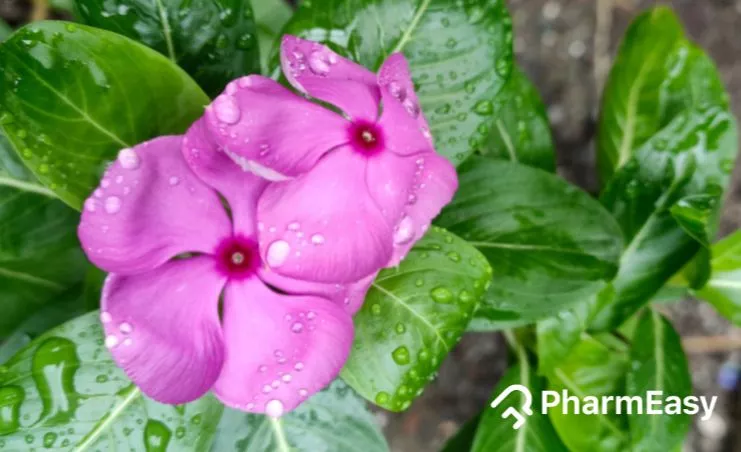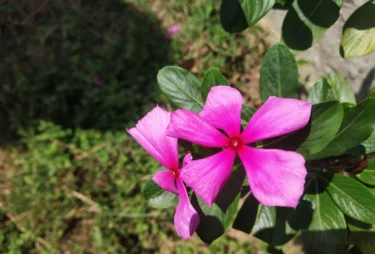Sadabahar (Periwinkle): Uses, Benefits, Side Effects and More By Dr. Rajeev Singh
By Dr Rajeev Singh +2 more

Get,

to manage your symptom
Get your,


4 Cr+ families
benefitted

OTP sent to 9988776655



You’ve successfully subscribed to receive
doctor-approved tips on
Whatsapp

Get ready to feel your best.

Hi There,
Download the PharmEasy App now!!


Register to Avail the Offer
Send OTPBy continuing, you agree with our Privacy Policy and Terms and Conditions

Hi There,
Sign up on PharmEasy now!!
Trusted by 4 crore+ families

OTP sent to 9988776655



You have unlocked 25% off on medicines




Code: NU25
By Dr Rajeev Singh +2 more
Table of Contents
Sadabahar or sadaphuli is a small shrub bearing purple, pink, or white flowers throughout the year and hence called “Sadabahar”. Natively called “periwinkle” in English Catharanthus roseus originated in Madagascar. This ornamental plant is cultivated throughout tropical and subtropical areas. Nearly 12 species are identified, out of which two are popular ground covers (a plant that grows over an area of ground). All the species bear single flowers and have opposite leaves. When the flowers are plucked, they exude a milky juice. The flowers bloom in March or April. Alba variety has white flowers, Atropurpurea has purple flowers, and Alboplena bears white flowers. Periwinkle is a rich source of medicinal compounds, and you need to know how nature has encapsulated love and care for all of us with this amazingly beautiful plant. Let us read more about the various health benefits Sadabahar leaves has to offer1.

Did you know?
Sadabahar leaves and flower petals are rich in flavonoids, alkaloids, carbohydrates and phytochemicals like vincristine, vinblastine, vincardine, etc. The nutritional components of Sadabahar leaves are mentioned below:
Nutritional value of Sadabahar leaves2
The Sadabahar plant might act as a “diuretic.” Taking Sadabahar might make the body less effective at eliminating lithium. Lithium levels may rise as a result, which may have various side effects. I suggest if you are on lithium, see your doctor before consuming Sadabahar in any form. You might need to adjust your lithium dosage.
Dr. Siddharth Gupta, B.A.M.S, M.D (Ayu)
Scientifically proven properties of Sadabahar include1:
Some of the potential benefits of Sadabahar are described as under:

Type-2 diabetes is a metabolic disorder characterized by derangements (abnormalities) in blood glucose levels, due to decreased insulin (a hormone that regulates blood glucose) response or insulin resistance. Nammi et al. conducted a study in 2003 to assess the effects of sadabahar leaf juice on diabetic rats. The findings of this study stated that sadabahar had an anti-diabetic effect, attributed to increased secretion of insulin from beta cells of the pancreas. This indicates that sadabahar leaves may help in managing diabetes. However, we need more studies to support these claims in humans3.

Hypertension is defined as systolic blood pressure >130 mm Hg and diastolic blood pressure>80 mm Hg. Sadabahar as an anti-hypertensive (causing a decrease in blood pressure) agent has been used in folklore medicine. Ara et al. conducted a study in 2009 in hypertensive rats fed sadabahar leaves extract. The results of this study supported the use of sadabahar to manage high blood pressure, indicating that it may positively impact blood pressure. However, we need more studies to ascertain these claims in humans4.

A literature review by Medina et al. In 2010 stated that sadabahar contains chemical compounds called alkaloids which are known to enhance cognitive function. This effect is attributed to the inhibition of an enzyme called phosphodiesterase enzyme. The inhibition of this enzyme increases the levels of bio-molecules known to regulate memory, learning, etc. This indicates that sadabahar can positively impact cognitive function5.

Androgenic Alopecia, or male pattern hair loss in men and female pattern hair loss in women, is a patterned and progressive hair loss. A review by Justin et al. was conducted in 2017, stating sadabahar may help manage androgenic alopecia. However, the exact mechanism behind this is unknown, and we need more scientific studies to claim these effects in humans6.

Vinca alkaloids are medicinal compounds obtained from the Madagascar periwinkle plant or sadabahar. Vinblastine, an important Vinca alkaloid, has anti-tumour activity and is widely used to manage testicular cancers. Vinorelbine, another alkaloid from sadabahar, finds use for managing breast cancers and osteosarcoma (bone cancer cells). This indicates that sadabahar may help manage cancers. However, the potent anticancer Vinca alkaloids are fully processed, and safety and toxicity are tested before use. We do not promote the use of sadabahar flowers or leaves for managing cancers7.

Though there are studies that show the benefits of Sadabahar in various conditions, but these are insufficient and there is a need for further studies to establish the true extent of the benefits of Sadabahar on human health.
Alzheimer’s disease (AD), a neurodegenerative illness of the central nervous system, affects 50–60% of people with dementia. It is distinguished by significant memory loss, emotional instability, and personality changes in later life. Studies have shown that the extracts of Sadabahar may aid in Alzheimer’s Disease as it has the potential to stimulate the nervous system. I suggest the consumption of Sadabahar with a doctor’s guidance and avoiding self-medication at all costs.
Dr. Rajeev Singh, BAMS
You must consult a qualified doctor before taking any herbal supplements. Do not discontinue or replace an ongoing treatment of modern medicine with an ayurvedic/herbal preparation without consulting a qualified doctor.
A few side effects related to the consumption of sadabahar include:
However, if you experience any adverse reactions to Sadabahar, it is advised to discontinue its intake and immediately contact a doctor or your Ayurvedic physician who has prescribed it. They will be able to guide you appropriately for your symptoms.
Also Read: Shankhpushpi: Benefits, Side Effects, Precautions & More!
Consuming Sadabahar is okay if taken in moderate amounts. However, general precautions must be followed in the following conditions:
Also Read: Sandalwood: Uses, Benefits, Side Effects & More!
However, you must always seek the advice of your Ayurvedic physician about the possible interaction of sadabahar with other drugs and follow the prescription thoroughly, as they will know your health condition and other medications you are taking3,9.
Also Read: Chitrakadi Vati: Uses, Benefits, Side Effects & More!
The scientific name of sadabahar is Catharanthus roseus1.
Depending on the colour of the flower, two-three varieties are known, these include Alba variety which has white flowers, Atropurpurea which has purple flowers and Alboplena bears white flowers1.
Yes, animal studies show that sadabahar has an anti-diabetic effect, attributed to increased secretion of insulin (a hormone that regulates blood glucose) from beta cells of the pancreas. However, we need more studies to support these claims in humans. Therefore, it is advised to consult a doctor for a proper treatment in case you suffer from diabetes3.
The safety data regarding the use of sadabahar in pregnancy and during breastfeeding is limited; therefore it is advised to take necessary cautions if you plan to add this herb to your dietary routine. It is advised to consult a doctor for proper advice11.
Loh et al. in 2008 stated that vincristine, an alkaloid derived from sadabahar can cause hair loss, constipation, hyponatremia (low sodium levels in the body) and peripheral neuropathy (nerve damage resulting in pain, weakness, etc). Additionally, the consumption of sadabahar petals or leaves in excess can result in unwanted effects like nausea, vomiting, headache and fever10.
Disclaimer: The information provided here is for educational/awareness purposes only and is not intended to be a substitute for medical treatment by a healthcare professional and should not be relied upon to diagnose or treat any medical condition. The reader should consult a registered medical practitioner to determine the appropriateness of the information and before consuming any medication. PharmEasy does not provide any guarantee or warranty (express or implied) regarding the accuracy, adequacy, completeness, legality, reliability or usefulness of the information; and disclaims any liability arising thereof.
Links and product recommendations in the information provided here are advertisements of third-party products available on the website. PharmEasy does not make any representation on the accuracy or suitability of such products/services. Advertisements do not influence the editorial decisions or content. The information in this blog is subject to change without notice. The authors and administrators reserve the right to modify, add, or remove content without notification. It is your responsibility to review this disclaimer regularly for any changes.
Comments

Leave your comment...
You may also like
Comments